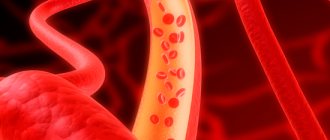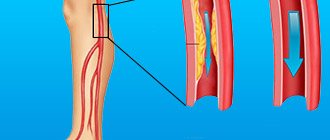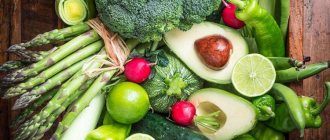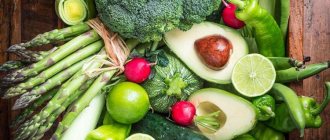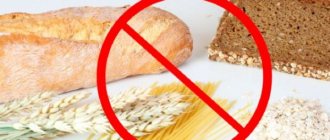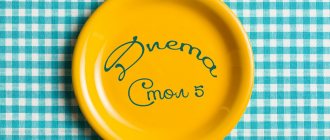( 2 ratings, average: 5.00 out of 5)
The diagnosis of atherosclerosis requires a mandatory revision of the daily menu, limitation or even complete rejection of a number of foods and drinks and the introduction of healthy foods into the diet. Such measures are necessary because the occurrence of the disease is directly related to certain unhealthy eating habits. Along with smoking, a sedentary lifestyle and stress, poor nutrition becomes a factor that aggravates the condition of a patient suffering from atherosclerosis. If adequate comprehensive measures are not taken, health becomes increasingly deteriorating and even an unfavorable outcome is possible.
Proper nutrition for atherosclerosis
A completely insufficient measure is a balanced menu, with the inclusion of foods with a certain ratio of vital components - microelements, vitamins, carbohydrates and proteins. Of course, such a menu will bring positive results. But the main task for patients with atherosclerosis is to strictly calculate the calorie content of the daily diet and follow the calorie standards established for their group. Calorie content is determined based on the following parameters:
- patient weight;
- age;
- Lifestyle;
- professional activity taking into account physical activity (the nature of the work performed and its intensity).
Considering that atherosclerosis is one of the main causes of death in people all over the world, you should carefully follow the recommendations of your doctor and nutritionists.
About alcohol and high cholesterol
Small doses of ethyl alcohol, as a chemical compound, can increase the level of “good” cholesterol. However, exceeding the alcohol limit forces the liver to direct all its efforts to quickly neutralize toxins and eliminate acetaldehyde, so the production of HDL stops. At the same time, the level of low-density lipoproteins does not change, due to which the total cholesterol level increases.
Additional negative factors are the destructive effect of ethanol on the walls of blood vessels (a cholesterol plaque forms at the site of microtrauma), clouding of consciousness provokes the consumption of foods from the prohibited list, disruption of the rhythmic functioning of the heart (with aortic atherosclerosis, it threatens a heart attack).
Ideally, patients with atherosclerosis should stop drinking alcohol. A single dose of strong alcohol is allowed for men not more than 100 ml, for women - 50 ml.
Diet for vascular atherosclerosis. Basic Rules
Following dietary and lifestyle recommendations is not at all as difficult a task as it might seem at first glance. The patient is required to have discipline and awareness of the importance of following the instructions necessary to maintain health, improve the quality of life in general and further have a positive prognosis. On the subject: How not to eat after 6 pm Doctors' orders include:
- Refusal from meat broths, fatty, salty and smoked foods and semi-finished products and replacing them with healthy dishes (stewed, boiled and baked).
- Regular meals (small portions) – four or more times a day.
- A balanced menu with optimal content of micro- and macroelements, carbohydrates and proteins.
- Limiting table salt.
- Hot spices/condiments are prohibited.
- Including a sufficient amount of fiber-rich foods in the menu.
- Lots of fresh vegetables and fruits.
- Consumption of low-fat dairy products (in doses indicated by a nutritionist).
If you are overweight, patients are required, under the supervision of specialists, to take measures to lose weight by practicing fasting days. Homemade weight loss and dietary nutrition without consulting a specialist is prohibited! Illiterate actions cause harm to the body. On the recommendation of a doctor, it is necessary to completely avoid or significantly limit the following products:
- sugar;
- candies and various sweets;
- mayonnaise;
- store-bought sauces;
- ketchup;
- bakery products made from wheat (white) flour;
- offal;
- red meat;
- sweet carbonated drinks;
- store-bought juices/nectars;
- cocoa;
- canned fish and meat;
- dried fruits (high in sugars);
- strong coffee and tea.
Preference should be given to foods with a low hypoglycemic index.
Limited product category
Cholesterol is necessary for the body for the full production of sex hormones, adrenal hormones, for the synthesis of vitamin D, as a building material and for the protection of cell membranes. Diet rules allow limited consumption of animal fats, in particular, you are allowed to eat 10-15 g of butter (per day).
Vegetable oils that do not contain cholesterol should be limited to people with excess body weight, as a source of additional calories. When choosing vegetable oil, preference should be given to products with a high content of Omega acids (olive, flaxseed, grape seed and milk thistle oils).
A rich source of Omega is fatty fish (sturgeon, halibut, capelin, mackerel). Their use is allowed once a week. In case of atherosclerosis accompanied by obesity, it is necessary to limit the consumption of pasta. They must be made from the highest varieties of wheat, devoid of gluten (category “A”).
The category of simple carbohydrates allowed for a normal BMI includes marmalade, dried fruits, and marshmallows. Soy sauce is allowed in the diet, however, it should not be abused due to the high salt content in the product.
The ban on pork consumption does not apply to lard, which contains arachidonic acid, a substance that increases high-density lipoprotein levels. Patients are allowed 10 g of lightly salted lard per day.
Important! The consumption of boiled and fried lard is strictly prohibited.
Nutritionist's recommendations
- The main diet should consist of high-density lipoproteins with a sufficient amount of digestible vitamins.
- Food is cooked mainly by steaming without the use of fat. Vegetable oil is used for dressing salads and other dishes.
- When cooking broth from lean meat, the cooled fat is skimmed off the surface.
- Fried foods, as well as canned foods and pickles, including home-made and factory-made canned meat and fish, are completely excluded.
- Smoked products are prohibited.
- There is no need to add salt during the cooking process. Table salt is used in small quantities when serving the dish.
- For home baking, use chicken protein, not yolk.
- The daily diet is five meals a day. This technique allows you to avoid overeating and minimize the feeling of hunger between meals.
Find out the causes of excess weight and ways to quickly lose weight
Sign up for a free initial appointment with a nutritionist!
The daily menu of a patient with atherosclerosis consists mainly of protein foods:
- lean meat;
- low-fat cottage cheese;
- fish.
Important! The volume of each of the above products is about 150 grams (daily).
What do protein-rich foods do?
With their help, you can create a long-lasting feeling of fullness. The human body takes longer to process such products. Therefore, repeated meals after a short period of time are not required.
Plant sterols in the diet of patients with atherosclerosis
Sterols are components that are contained in:
- in natural vegetable oils;
- in nuts;
- in legumes;
- in cereals.
Thanks to sterols, excess cholesterol is not absorbed into the bloodstream. Thus, foods high in sterols become part of a comprehensive program for the management of patients with vascular atherosclerosis. The daily norm of sterols is about two grams.
Key rules of eating behavior
According to diet number 10, all foods are divided into three categories: prohibited, limited (restricted for consumption) and allowed. The distinction is primarily associated with foods rich in animal fats, from which “bad” cholesterol is formed.
General principles for organizing proper nutrition:
- eliminate prohibited products from the menu;
- introduce foods high in fiber, omega acids, polyphenols, and ascorbic acid into your diet;
- do not get carried away with products from the limited category;
- do not be greedy in food, that is, do not overeat;
- control the daily intake of calories, nutrients, drinking water;
- Avoid dishes prepared by frying (including frying in vegetable oil). Cooking food is allowed by boiling, stewing, steaming, baking under foil (brown crust on dishes is not welcome);
- reduce the consumption of salt and salty foods as much as possible;
- Follow the eating schedule - every 3-4 hours in small portions.
It is recommended to enrich the daily menu with restorative decoctions according to traditional medicine recipes.
Diet for different types of illness
Atherosclerosis is a disease that affects various organs, from the brain to the lower extremities. Despite the fact that the disease is classified as one pathology, the approach to treating the patient and the selection of food products is an individual task.
Diet for atherosclerosis of the vessels of the lower extremities
When diagnosing this type of disease, you should stop smoking and alcohol, increase physical activity and review your diet. It is necessary to undergo comprehensive examinations of the body in order to identify possible concomitant diseases and obtain advice from specialists. On the subject: How to control appetite The goal of the diet is to reduce cholesterol levels in the blood. Improve blood composition. Properly selected food products can replace fatty acids that are harmful to the body with beneficial unsaturated acids. The following products are recommended:
- rich in vegetable protein (legumes, corn, wheat, soy);
- bran;
- seasonal berries;
- fruits;
- a variety of vegetables;
- sea fish (steamed or baked);
- milk, kefir and cottage cheese (with low fat content);
- compote of dried apples, pears, dried apricots, etc.
Weak tea and coffee, lean meat (boiled, baked, stewed) are allowed.
Diet for cerebral atherosclerosis
The list of permitted products is quite long. It includes:
- Milk, cottage cheese, kefir.
- Green and black tea.
- Natural coffee (instant or brewed).
- Fresh (not packaged) juice (berry, fruit and vegetable).
- Rose hip decoction.
- Bran.
- Bakery products (1st and 2nd grade wheat and rye flour).
- Biscuits without synthetic additives (dyes, flavor enhancers, etc. are prohibited).
- Baked goods (no salt, no sweet buns).
- First courses (lenten, not with meat broth) - beetroot soups, vegetable soups, cereals, borscht without meat in water, etc.
- Sea products.
- Butter (butter to add to the dish before serving, various vegetable oils).
- Chicken eggs (soft-boiled) and omelettes (no more than three per week).
- Greens and a variety of vegetables.
- Porridge and casserole made from cereals - oats, millet, buckwheat.
- Rice (not much).
- Pasta (limited).
- Jam, marmalade (small quantity).
- Natural honey (not a lot).
- Sugar (doses are strictly controlled).
- Desserts (unsweetened, natural jelly or mousse).
General recommendations: limit your salt intake, replace animal fat with vegetable oil.
Do cholesterol-lowering medications help?
A large number of pharmaceutical products designed to lower cholesterol have no effect. To normalize cholesterol, it is enough to follow the rules of nutrition, give up bad habits and lead an active lifestyle. Include in your menu dishes rich in vitamins (especially ascorbic acid and Vitamin B and P). Food should be prepared without table salt, adding it in minimal quantities to ready-made dishes. The norm is no more than 3-5 grams per day.
Briefly about the development of atherosclerosis
An increase in total cholesterol levels is the result of dyslipidemia (impaired ratio of lipoproteins of different densities). After absorption of fats from the intestines into the blood, cholesterol, in correlation with proteins, forms low and high density lipoproteins (LDL - “bad” cholesterol and HDL - “good” cholesterol).
The former are responsible for the delivery of fats from the liver to the body tissues, the latter are responsible for the timely movement of excess “bad” cholesterol to the liver for disposal. With an excessive amount of low-density lipoproteins and the presence of damage on the inner layer of the vascular wall, part of the LDL “clings” to the injured area, forming a compaction (plaque).
As it increases, the vessel loses its elasticity and narrows, disrupting the natural blood supply to the organs. Atherosclerosis mainly affects:
- anterior, posterior and carotid arteries of the neck, supplying blood to the brain (cerebral atherosclerosis);
- vessels of the lower extremities;
- coronary arteries and thoracic aorta of the heart;
- renal vessels.
Cholesterol growths cause strokes, heart attacks, coronary heart disease, dry gangrene of the legs, and renal decompensation. Diet therapy helps prevent early complications and improve quality of life. A properly formulated diet allows you to minimize the intake of “bad” cholesterol and increase the amount of “good” high-density lipoproteins.
Reference! The average norm of total cholesterol for adults is 3.2-5.2 mmol/l. Hypercholesterolemia is considered to be > 6.7 mmol/l.
Diet for atherosclerosis. Menu for the week
The approach to therapeutic nutrition is based on excluding cholesterol-supplying foods from the menu. These are low-density lipoproteins that provoke the formation of atherosclerotic plaques on the vascular walls. Reducing cholesterol is quite possible! Eating the “right” foods and avoiding unhealthy foods will reduce the negative consequences of the disease. In many cases, thanks to a well-designed menu, it is possible to reduce the doses of medications consumed and stop taking certain medications.
| Day of the week | Dishes/food and drinks |
| Monday | First breakfast:
Lunch:
Dinner:
Afternoon snack:
Dinner:
|
| Tuesday | Morning:
Second meal:
Dinner:
Lunch:
Dinner:
|
| Wednesday | First meal:
Lunch:
Second meal:
Second lunch:
Dinner:
|
| Thursday | For breakfast:
Lunch:
At lunch:
For afternoon tea:
For dinner:
|
| Friday | First breakfast:
Lunch:
Dinner:
Porridge with stewed meat:
Afternoon snack:
Dinner:
Boiled fish:
|
| Saturday | Morning:
For lunch:
Dinner:
Lunch two:
Dinner:
|
| Sunday | First breakfast:
Lunch:
For lunch:
Lunch:
For dinner:
|
The disease should be treated by a doctor. A patient with atherosclerosis must be constantly monitored by specialists, undergo examinations and consult with nutritionists. These patients usually take many different medications. Drug therapy in these cases is mandatory! But special attention is also paid to dietary nutrition. The further medical prognosis depends on the patient’s discipline. It will be favorable if the patient strictly follows all recommendations.
Diet for atherosclerosis of the carotid arteries
Advanced stage of the disease often requires surgery. In this case, we are talking about saving the life of the patient. Therefore, the best solution would be not to start the disease, but to use effective prevention methods. If you are overweight you must:
- under the supervision of doctors, take the necessary measures to reduce body weight (it is prohibited to either suddenly lose weight or quickly gain body weight);
- give up bad eating habits and snacks late in the evening before bed and/or at night;
- apply therapeutic and preventive diets recommended by specialists.
Example of a menu for a patient
Morning:
- Vinaigrette seasoned with vegetable oil.
- Boiled meat (lean).
- Tea or coffee with milk (not fatty).
Lunch:
- Vegetable or fruit salads.
Dinner:
- Lenten vegetable or cereal soup.
- Steamed fish.
- Boiled potatoes.
- Dried fruits compote.
Afternoon snack:
- Fruits (apples, oranges)
- Rosehip decoction without sugar.
Evening:
- Cottage cheese casserole with tea.
To reduce appetite between meals, you should drink water or eat one unsweetened fruit. Patients must be under the constant supervision of experienced doctors and nutritionists, undergo the required examinations, be monitored over time and take medications (only as prescribed by the attending physician!)
Diet for atherosclerosis of the aorta
With this diagnosis, patients almost always suffer from high blood pressure. The first priority is to stabilize it. And one of the main recipes is proper nutrition. A competent daily menu includes:
- healthy foods (cereals, potatoes, tomatoes, cabbage available to everyone);
- exclusion of animal fats;
- obtaining carbohydrates from fruits and vegetables.
It is also important to consume food with plenty of microelements, especially iodine. Seafood products are shown, such as fish and kelp (seaweed). Such food products contain many vital microelements and vitamins that are beneficial to the patient, including vitamin B.
Proper nutrition is aimed not only at normalizing blood pressure, but also at strengthening blood vessels and the heart muscle. This should become a rule and be practiced regularly, not occasionally. The menu should be supplemented with other preventive and therapeutic methods:
- performing feasible physical exercises;
- daily walks in the air;
- race walking;
- psychotherapy with the goal of changing the worldview to a positive perception of the world, etc.
Table No. 10 and examples of dietary dishes for atherosclerosis
When creating a menu, you must use only the components of the permitted food basket, follow the rules for eating and cooking food. For ease of use of the diet, the diet is developed for a week. Breakfast options:
- omelet cooked in the microwave with the addition of herbs, tomatoes, low-fat cheese;
- porridge cooked on a milk or water basis from oatmeal, wheat or rice;
- cheesecakes baked in the oven;
- lazy dumplings with cottage cheese.
Fresh fruit, fruit puree, berry mousse, oven-baked apples, fruit cocktail or salad are suitable for lunch (second breakfast). You can supplement your snack with biscuits and unsweetened cookies. Lunch should include two courses. You can combine products to suit your taste.
Salads:
- vegetable (tomatoes + herbs + cucumbers + vegetable oil);
- vitamin (white or Chinese cabbage + carrots + olive oil);
- the vinaigrette;
- beetroot (boiled beets + garlic + walnuts + sour cream 10% fat);
- carrots in Korean.
First meal:
- chicken soup with vermicelli (homemade noodles);
- bean soup with chicken broth;
- vegetarian cabbage soup;
- cold borscht or gazpacho;
- fish soup with pearl barley.
Important! Sautéing vegetables to season soup is prohibited. The broth is made from low-fat fish. Before preparing chicken broth, you must first remove the skin from the bird.
For an afternoon snack, we offer cottage cheese casserole with apples, fresh cottage cheese with natural yoghurt and berries, ready-made grain cottage cheese with rye bread, and fermented baked milk with unsweetened cookies. It will be useful to add a tablespoon of bran to cottage cheese or fermented baked milk. Dishes for evening meals:
- pilaf with chicken breast;
- boiled fish with mashed potatoes;
- steamed turkey cutlets with crumbly pearl barley or buckwheat;
- vegetable stew;
- steamed fish cutlets with boiled rice;
- chicken meatballs steamed with boiled cauliflower or broccoli;
- potato casserole with tofu cheese.
All dishes must be supplemented with fresh vegetables, sauerkraut (limited), canned peas, ready-made seaweed salad, and fresh herbs. These foods will help bind and eliminate cholesterol. To improve digestion and prevent evening hunger, it is recommended to drink a glass of low-fat fermented milk drink (kefir, acidophilus) two hours before bedtime.
Diet number for atherosclerosis
This is an effective therapeutic diet No. 10, developed by Professor M. I. Pevzner and diet No. 10-a. Indications (basic diet No. 10):
- diseases of the heart and blood vessels, in which circulatory failure is diagnosed (first and second degree).
Indications for therapeutic diet No. 10-a:
- atherosclerosis of blood vessels of the brain and heart;
- cardiac ischemia;
- arterial hypertension (against the background of atherosclerosis).
Difference between diet No. 10 and No. 10-a
Basic diet No. 10
- There are no restrictions on the consumption of eggs and dishes made from them.
- Non-fat trimmed pork is allowed.
Diet No. 10-a
- Pork is excluded altogether.
- Eggs are allowed no more than three times in seven days (one piece - soft-boiled or omelet).
- Limiting rice and semolina dishes.
- Permission for small quantities of pasta.
The emphasis for both diets is on strict adherence to the rules for preparing permitted dishes (cooking for patients with atherosclerosis: see above). The therapeutic nutrition program has found application in sanatoriums, hospitals and other medical institutions. It is part of the list of dietary tables (total number - 15) recommended for patients suffering from various diseases. Doctors, if necessary, make their own adjustments to the therapeutic diet. For example, in case of obesity, special attention is paid to reducing the total calorie content of meals (per day). Note: It is possible to expand or limit the menu (depending on the individual course of the disease in a particular patient, as well as other special factors).
- Ideally, a patient with atherosclerosis, regardless of health status and the presence of concomitant diseases, should eat six times a day.
- The portion of the first course (for lunch) is half less than the traditional one recommended for a healthy adult.
- Bakery products and sugar are limited.
- The drinking regime should be observed. The optimal amount of liquid per day is no more than one liter (this is the total volume of liquid consumed!) This includes clean water, juice, compote, tea, coffee, as well as the volume of first courses (soups, borscht).
General Diet Information
Nutrition for atherosclerosis of the vessels of the brain, heart and legs is organized in accordance with the rules of the therapeutic diet “Table No. 10” (according to V. Pevzner’s classification). Correction of eating habits is aimed at reducing the level of low-density lipoproteins in the blood, cleansing the vascular system of cholesterol build-ups, and improving blood flow.
Hypercholesterolemia is not an indicator of obesity. Vessels clogged with cholesterol plaques are not uncommon for slender and even thin patients. Therefore, the nutritional system has two varieties, differing in calorie content and the amount of necessary nutrients.
Recommended standards
| Type of diet | Complex carbohydrates | Simple carbohydrates | Protein | Lipids (fats) | Drinking water | Daily caloric intake |
| For patients with normal BMI | up to 350 g | up to 50 g | 100 g, ratio of plant and animal proteins - 50×50 | 80 g, vegetable to animal – 40×60 | 1200-1500 ml | 2500 kcal |
| For patients with high BMI | 300 g | exclude | 80 g, ratio of plant and animal proteins - 50×50 | 70 g, vegetable to animal – 60×40 | 1200-1500 ml | 2000 kcal |
BMI – body mass index, calculated by the formula:
The normal value is BMI=25. Higher scores indicate overweight.
Which diet is best for atherosclerosis?
Treatment of such a serious disease as atherosclerosis requires the mandatory participation of specialists. These are doctors of different specialties - cardiologists, therapists, nutritionists. The question of the best diet cannot be answered unequivocally. Here are general universal recommendations for proper nutrition. Each patient's disease has its own characteristics. In addition, concomitant pathologies are often detected, many of which are quite severe. Therefore, the attending physician gives recommendations on an individual basis for each patient. Treatment of the disease is a difficult task, and therapy lasts a long period, almost a lifetime. A well-chosen diet “works” for the overall goal and greatly contributes to a positive result. By consuming healthy foods, the patient will be able to:
- reduce the amount of cholesterol in the blood;
- strengthen the body’s general defenses (increase immunity);
- stabilize body weight;
- maintain normal blood pressure.
However, other measures are also required from patients with atherosclerosis - a mandatory increase in physical activity, giving up bad habits, including eating habits, maintaining a daily routine and ensuring sufficient rest and sleep.
Related posts:
Intuitive eating technique
Complications of obesity
How to choose the right training courses in dietetics and nutrition
Review of weight loss complexes - how do they work and is there a catch?
How to find motivation to lose weight
Test check yourself:
fact or fiction?
Eating more fruit can improve bone density.
Correct! Wrong!
Consuming foods with plenty of bioavailable calcium improves bone density. Fruits generally do not contain much calcium.
Excess protein accumulates in the muscles, causing them to increase.
Correct! Wrong!
Once the need for protein and energy has been met, excess amino acids are converted to acetyl-CoA, from which they are converted into fatty acids and stored in adipocytes. Therefore, excess protein will not be converted into muscle.
Where does atherosclerosis come from?
The main reason for the development of atherosclerosis is a violation of lipid metabolism, which results in the accumulation of cholesterol in the lumen of blood vessels and their further blockage with atherosclerotic plaques. As a result, blood circulation deteriorates, blood thickens and, as a result, blood pressure increases.
In the future, atherosclerosis leads to coronary heart disease and various diseases of the central nervous system, including the already mentioned stroke. But the main root of this problem lies in a person’s unhealthy lifestyle and unbalanced diet.
Regular overeating, abuse of high-calorie fatty and/or fried foods, excess of saturated and hydrogenated fats in the diet causes excess weight and metabolic disorders, which ultimately ends in a diagnosis of atherosclerosis.
That is why the first thing doctors pay attention to after stating this fact is the need to follow a special therapeutic diet. Moreover, changes in diet should occur not only at the time of the acute period or rehabilitation, but throughout life.
Without normalizing your diet, you shouldn’t expect much effect from drug treatment. Even if it is possible to improve the patient’s condition, it will only be for a while, and then an incorrect diet will again lead to a relapse and exacerbation of atherosclerosis with all the ensuing consequences.
General rules
Initial signs atherosclerosis can be seen even in ten-year-old children. The initial stage is characterized by the appearance of spots and stripes in the wall of the arteries that contain lipids ( lipidosis ).
Lipid spots occupy 10% of the surface of the aorta at the age of 10, and by the age of 25 they occupy 30-50% of the surface. In the coronary arteries, lipidosis develops earlier and occurs already at 10-15 years, and lipidosis of cerebral vessels - by 35-45 years. It is at this initial stage that treatment is most effective. Nutrition plays an important role in this. It turns out that prevention of atherosclerosis needs to be done from childhood.
An increase in free cholesterol and LDL fractions leads to the progression of atherosclerosis: the atherosclerotic plaque grows, the narrowing of the artery lumen progresses and the blood supply to the organ is disrupted. When the blood flow deficit is 50-70%, clinical signs develop.
With atherosclerosis of the carotid arteries, numbness or weakness in the arms or legs and speech impairment appear. If the coronary vessels are damaged, angina pectoris occurs . In such cases, anti-atherosclerotic therapy, treatment of the disease caused by atherosclerosis and nutritional therapy are prescribed.
The diet for vascular atherosclerosis is aimed at slowing the development of the disease. Its goal is to eliminate metabolic disorders, lose weight and improve blood circulation. The general principles are to reduce animal fat and carbohydrates (fast, easily digestible) in the diet.
The degree of restriction of fats and carbohydrates depends on the patient’s weight. The protein content is within the physiological norm. Salt (up to 8-10 g per day in all dishes), the amount of liquid consumed (maximum 1.2 l), cholesterol (0.3 g) and extractive substances are limited. The amount of vitamins ( C and B ), linoleic acid , dietary fiber, lipotropic substances, potassium, magnesium has been increased due to an increase in vegetable oils, vegetables, fruits, seafood and cottage cheese in the diet. Dishes are prepared without salt, and then the finished food is salted at the table.
Vegetables with coarse fiber are boiled or stewed, meat and fish are boiled. Meals are provided 5 times a day in small portions.
Foods that raise cholesterol levels
All animal products contain cholesterol and 20% of it comes from food, and the remaining 80% is produced in the body. It is low-density cholesterol that plays a role in the development of this disease, while high-density cholesterol prevents the formation of plaques. Modern man cannot completely give up animal products.
Diet for atherosclerosis of the heart vessels , as well as for atherosclerosis of other vessels, allows periodic consumption of these products, but with a low cholesterol content. Of course, you need to give up “cholesterol concentrates”: brains, offal, egg yolk, as well as dangerous trans fats (mayonnaise, margarine). A little butter is allowed.
According to research, the danger is not cholesterol in foods, but the lack of sufficient fiber in food, which comes from vegetables, fruits, and bran. The real enemies of this disease are refined carbohydrates. Therefore, with atherosclerosis of the aorta and heart vessels, sugar, flour products, potatoes and baked goods in the form of semi-finished products are limited.
Considering that aortic atherosclerosis is observed in people over 50 years of age who suffer from obesity and concomitant diabetes mellitus , limiting carbohydrates will only be beneficial. Violation of the structure of the vascular wall of the aorta leads to the formation of an aneurysm, which enlarges and thins and can lead to rupture of this large artery.
Permitted and prohibited foods for atherosclerosis
Now let's move on directly to the menu that can be recommended for people with atherosclerosis.
List of permitted products:
- Meat (in small quantities!): chicken and turkey fillet, rabbit, lean veal, skinless chicken, quail.
- Fish: all white fish (cod, flounder), herring, sardines, tuna, salmon (chum salmon, pink salmon, salmon).
- Fats: olive, sunflower, soybean, corn oil, nuts, seeds (sesame, flax, chia).
- Dairy and fermented milk products: skim milk, low-fat cheeses (pressed cottage cheese), kefir, yogurt, natural yogurt, low-fat cheese, ayran.
- Legumes: peas, beans, lentils, asparagus, soybeans.
- Vegetables and fruits: carrots, beets, tomatoes, cucumbers, onions, garlic, zucchini, peppers, eggplants, cabbage, boiled potatoes (or in their jackets).
- Cereals: buckwheat, oatmeal, brown rice, pasta and wholemeal bread.
- Baked goods: low fat puddings, jellies, sorbet.
- Drinks: green tea, natural fresh juices without sugar, compote or uzvar without sugar, still mineral water.
Comments from nutritionists
The question is often asked: will fasting help cope with atherosclerosis? Indeed, therapeutic fasting can be used in the treatment of the initial stages of the disease. However, there are contraindications: arrhythmias , severe atherosclerosis , thyrotoxicosis , a tendency to thrombosis , liver and kidney pathology and others. In the absence of contraindications, short-term unloading can be carried out. However, the effectiveness of therapeutic fasting in the treatment of this disease is currently being questioned, and it has not been scientifically confirmed. Some studies (on birds) have confirmed the opposite - metabolic disorders during fasting, on the contrary, lead to hypercholesterolemia .
The rule of life for such patients should be a balanced diet, and this dietary table meets all the requirements and takes into account all the main aspects of nutrition that lead to the progression of the disease. It is very important to maintain high-density cholesterol levels. This is possible due to the daily intake of omega-3 PUFAs from food, since they are not formed in the body. Their daily requirement is 2 g. As a guide, we present the content of 100 g of products: flax seed is in the lead - 22.8 g, walnuts are in second place - 6.8 g, mackerel - 2.5 g, herring - 1.5-3, 1 g, tuna - up to 1.6 g, soy - 1.6 g, salmon - 1.4 g.
Nuts for atherosclerosis
Next, you need to consume up to 500 g of fruits and vegetables (potatoes are not taken into account). The dietary fiber of these products absorbs cholesterol; it is not absorbed into the blood and is excreted in feces. The daily requirement for dietary fiber is 25-30 g. A very large amount of it (2.5 g per 100 g of product) is found in wheat bran, beans, whole oatmeal, nuts, dates, cranberries, gooseberries, raspberries, figs, prunes, raisins and dried apricots. Slightly less (1-2 g) in cereals: buckwheat, barley, pearl barley, oat flakes, peas, carrots, cabbage, sweet peppers, eggplants, pumpkin, quince, oranges, fresh mushrooms.
In this disease, the role of antioxidants - vitamins A , E , C and selenium . Sources of vitamin A are sea fish, all citrus fruits, chicken egg yolk, carrots, tomatoes, apricots, pumpkin, spinach.
Vitamin C is found in all vegetables and fruits, but the greatest amount is in rose hips, black currants, sea buckthorn, green peas, red peppers, Brussels sprouts and cauliflower.
Vitamin E is present in all vegetable oils, cereals, legumes, sunflower seeds, almonds, and peanuts. We get selenium from tuna, sardines, beef, and milk.
While actively pursuing your health, avoid foods that contain hidden animal fats. We are talking about sausages, sausages, ham, rolls, pates, cheeses, curd mass. Choose lean meats and additionally eliminate visible fat. When preparing dishes, use a minimum of fat - this will be possible if you use a double boiler, oven and grill.
Eat less or completely eliminate “fast”, simple carbohydrates (sugar, cakes, sweet pastries, sweets, preserves, jams). The fact is that they stimulate the body's production of insulin , which is involved in converting excess sugars into fat and also stimulates appetite. You should also consider limiting salt in your diet. It makes it difficult to break down fats, and under its influence the inner wall of blood vessels becomes loose and susceptible to cholesterol deposition.
Now, knowing the basic directions of proper nutrition, it will not be difficult to create a daily diet. The diet for atherosclerosis of the vessels of the lower extremities is no different from the general diet for this disease. In this case, a lipid-lowering diet is also prescribed - Table No. 10C or its variants (see above).
With obliterating atherosclerosis , a violation of the blood supply to the lower extremities comes to the fore, which is manifested by chilliness and numbness of the feet, cramps of the calf muscles, fatigue of the legs and intermittent claudication. In severe cases - trophic foot ulcers and gangrene . Therefore, treatment is prescribed in parallel, including a group of vascular drugs ( Trental , Vazaprostan , Ilomedin ), thrombolytics and, of course, statins - lipid-lowering drugs. The patient needs to change their lifestyle (quitting smoking and drinking alcohol), control weight and increase (if possible) physical activity.
Authorized Products
Vegetable soups, cabbage soup, beetroot borscht, vegetarian soups with potatoes and a small amount of cereal are allowed (everything except semolina and rice).
Meat and poultry should be selected from low-fat varieties and served boiled or baked, chopped or in pieces.
The basis of the weekly diet should be fish and seafood dishes, including seaweed.
Fish and seafood
The side dish is prepared from all types of cabbage, carrots, beets, eggplants, zucchini, pumpkin, potatoes and green peas. Cucumbers, white cabbage, tomatoes, lettuce, and greens are consumed fresh.
When sitting down at the table, you need to fill half the plate with vegetable salad, 2/3 of the remaining half with porridge, and the remaining half with protein products. As for appetizers, vinaigrettes and salads seasoned with vegetable oil are allowed, daily consumption of seaweed, jellied fish and meat, soaked herring, lightly salted cheese, low-fat ham and dietary sausages are mandatory.
Bread may be made from wheat, rye, soy flour, wholemeal flour, grain flour, or with bran. Dry, unpalatable cookies. Baked products are made with the addition of wheat bran and without salt. The filling can be cottage cheese, cabbage, fish or meat.
Milk and fermented milk products are consumed with reduced fat content, low-fat cottage cheese or 5% and 9% fat content, sour cream is allowed only in dishes. Eggs are allowed up to 3 eggs per week and are prepared soft-boiled or in the form of omelettes. From buckwheat, oatmeal, millet and barley cereals, crumbly porridges, cereals and casseroles are prepared with the addition of vegetables or cottage cheese.
Fruits and berries are consumed raw, in compotes, and jellies. They are prepared semi-sweet or with xylitol. If necessary, sauces are prepared with vegetable broth, milk and tomato sauces, seasoned with sour cream. Weak tea with milk, coffee drinks, weak coffee, vegetable, berry or fruit juices are allowed.
Daily intake of rosehip decoction and wheat bran. Dietary butter and vegetable oils are used for cooking and in dishes. Enrich your diet with fresh garlic if there are no contraindications from the gastrointestinal tract. It is a good anti-sclerotic agent. Fenugreek seeds and flax seeds, ground in a coffee grinder, should be added regularly to food as they help reduce cholesterol levels.
Table of permitted products
| Proteins, g | Fats, g | Carbohydrates, g | Calories, kcal | |
Vegetables and greens | ||||
| greenery | 2,6 | 0,4 | 5,2 | 36 |
| eggplant | 1,2 | 0,1 | 4,5 | 24 |
| beans | 6,0 | 0,1 | 8,5 | 57 |
| zucchini | 0,6 | 0,3 | 4,6 | 24 |
| cabbage | 1,8 | 0,1 | 4,7 | 27 |
| broccoli | 3,0 | 0,4 | 5,2 | 28 |
| boiled cauliflower | 1,8 | 0,3 | 4,0 | 29 |
| bulb onions | 1,4 | 0,0 | 10,4 | 41 |
| carrot | 1,3 | 0,1 | 6,9 | 32 |
| cucumbers | 0,8 | 0,1 | 2,8 | 15 |
| salad pepper | 1,3 | 0,0 | 5,3 | 27 |
| salad | 1,2 | 0,3 | 1,3 | 12 |
| beet | 1,5 | 0,1 | 8,8 | 40 |
| celery | 0,9 | 0,1 | 2,1 | 12 |
| soybeans | 34,9 | 17,3 | 17,3 | 381 |
| asparagus | 1,9 | 0,1 | 3,1 | 20 |
| tomatoes | 0,6 | 0,2 | 4,2 | 20 |
| Jerusalem artichoke | 2,1 | 0,1 | 12,8 | 61 |
| pumpkin | 1,3 | 0,3 | 7,7 | 28 |
| beans | 7,8 | 0,5 | 21,5 | 123 |
| garlic | 6,5 | 0,5 | 29,9 | 143 |
| lentils | 24,0 | 1,5 | 42,7 | 284 |
Fruits | ||||
| avocado | 2,0 | 20,0 | 7,4 | 208 |
| oranges | 0,9 | 0,2 | 8,1 | 36 |
| pomegranate | 0,9 | 0,0 | 13,9 | 52 |
| grapefruit | 0,7 | 0,2 | 6,5 | 29 |
| pears | 0,4 | 0,3 | 10,9 | 42 |
| kiwi | 1,0 | 0,6 | 10,3 | 48 |
| lemons | 0,9 | 0,1 | 3,0 | 16 |
| mango | 0,5 | 0,3 | 11,5 | 67 |
| tangerines | 0,8 | 0,2 | 7,5 | 33 |
| nectarine | 0,9 | 0,2 | 11,8 | 48 |
| peaches | 0,9 | 0,1 | 11,3 | 46 |
| apples | 0,4 | 0,4 | 9,8 | 47 |
Berries | ||||
| Red currants | 0,6 | 0,2 | 7,7 | 43 |
| black currant | 1,0 | 0,4 | 7,3 | 44 |
Nuts and dried fruits | ||||
| nuts | 15,0 | 40,0 | 20,0 | 500 |
| cashew | 25,7 | 54,1 | 13,2 | 643 |
| sesame | 19,4 | 48,7 | 12,2 | 565 |
| flax seeds | 18,3 | 42,2 | 28,9 | 534 |
| fenugreek seeds | 23,0 | 6,4 | 58,3 | 323 |
| sunflower seeds | 20,7 | 52,9 | 3,4 | 578 |
Cereals and porridges | ||||
| buckwheat (kernel) | 12,6 | 3,3 | 62,1 | 313 |
| oat groats | 12,3 | 6,1 | 59,5 | 342 |
| cereals | 11,9 | 7,2 | 69,3 | 366 |
| millet cereal | 11,5 | 3,3 | 69,3 | 348 |
| barley grits | 10,4 | 1,3 | 66,3 | 324 |
Raw materials and seasonings | ||||
| honey | 0,8 | 0,0 | 81,5 | 329 |
Dairy | ||||
| skim milk | 2,0 | 0,1 | 4,8 | 31 |
| natural yogurt 2% | 4,3 | 2,0 | 6,2 | 60 |
Cheeses and cottage cheese | ||||
| cottage cheese 0.6% (low fat) | 18,0 | 0,6 | 1,8 | 88 |
| curd tofu | 8,1 | 4,2 | 0,6 | 73 |
Meat products | ||||
| beef | 18,9 | 19,4 | 0,0 | 187 |
| rabbit | 21,0 | 8,0 | 0,0 | 156 |
Sausages | ||||
| boiled diet sausage | 12,1 | 13,5 | 0,0 | 170 |
Bird | ||||
| chicken fillet | 23,1 | 1,2 | 0,0 | 110 |
| turkey | 19,2 | 0,7 | 0,0 | 84 |
Fish and seafood | ||||
| fish | 18,5 | 4,9 | 0,0 | 136 |
| squid | 21,2 | 2,8 | 2,0 | 122 |
| mussels | 9,1 | 1,5 | 0,0 | 50 |
| seaweed | 0,8 | 5,1 | 0,0 | 49 |
Oils and fats | ||||
| butter | 0,5 | 82,5 | 0,8 | 748 |
| linseed oil | 0,0 | 99,8 | 0,0 | 898 |
| olive oil | 0,0 | 99,8 | 0,0 | 898 |
| sunflower oil | 0,0 | 99,9 | 0,0 | 899 |
Non-alcoholic drinks | ||||
| mineral water | 0,0 | 0,0 | 0,0 | — |
| green tea | 0,0 | 0,0 | 0,0 | — |
| * data is per 100 g of product | ||||
